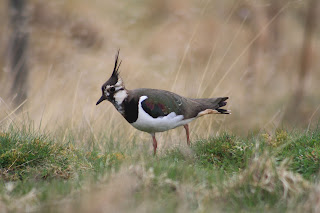The little tourist boat out of Ulver Ferry on the Isle of Mull drew towards the towering cliffs of Lunga, largest and northernmost of the Trennish Isles, the chain of rocky little basalt islands in the Inner Hebrides, north of the famous Fingal’s Cave on the isle of Staffa, that great monument to undersea volcanism and geological forces. The water we crossed was crystal clear, and rich in life, fish weaving between fronds of waving kelp beneath the surface, moon jellies, and occasionally more unusual cnidaria, drifting everywhere. At one point even Common Dolphins were leaping beside us. We docked at a rocky promontory on the island and made our way ashore on the columnar basalt, climbing a short cliff path. The skipper had warned us the birds would hypnotise us, that we’d risk falling into a trance on the cliff path, and would have to come back to the boat without seeing the spectacular heart of the seabird city which lines the steepest cliffs. His warning was spot on, but not heeded.
We sat up on the cliff top, among the wild flowers, the Bird’s foot trefoil and
Burnett moths, on the rabbit-grazed, short grass, and watched the comings and
goings of the Atlantic Puffins (Fratercula arctica) for hours. Birds
flew in off the clear blue water, on wings beating rapidly, with thick, vivid
coloured beaks full of silver sandeels. Adults
with food swiftly disappeared into their burrows, even Puffins are not averse
to nicking their neighbours’ food, and to the gulls and skuas a Puffin with food
on land is an obvious target. So, they take
their food underground hurridly, and unload it for the subterranean Puffling,
the single, fluffy youngster waiting in the burrow. Puffins without bills full of food seemed to
enjoy a more leisurely lifestyle, taking some time to enjoy the sun and each
other, pairs bill-rubbing and calling to each other, enjoying the bonds which
hold them together, companionable, almost romantic. We were, naturally, enchanted
by these entertaining little seabirds, and never made the journey across the little
island to the spectacular Guillemots and Kittiwakes up on the towering sea
stacks.
My paternal Grandma loved Puffins, and as such I must have drawn and painted
hundreds of pictures of them, and bought puffin calendars and birthday cards
for her every year. Images of them adorned her home. They were here favourite bird, and as such
have always held a special place in my heart. However I was in my mid-twenties
by the time I saw one, on another chain of islands on the West coast, right down
in the Scillies. Puffins tend to live far
from us, on rocky offshore islands, like the Scillies or the Trennish, or famously
on Lundy, where the Bristol Channel meets the Atlantic. They visit the coastline only briefly,
setting up in April, and gone by the end of July. Their vanishing act is thorough
and though wintering puffins were encountered at sea from time to time, it wasn’t
fully understood until the advent of geotagging. Once their Puffling has come waddling out under
the sky for the first time, and taken to the sea, the parents remaining tie to
land is severed. They shed the bright, temporary sheath which has grown around their
bill, and darker feathers grow around the eye, masking the big, white face
patches. They loose the ability to fly
during the Autumn moult, and spend the winter upon the ocean waves, living like
the penguins of the Southern hemisphere, undertaking deep dives, wings adapted
for ‘flying’ underwater. The black and white countershading Puffins, plus several
related Auks share with Penguins are an example of convergent evolution, where
similar evolutionary pressures lead to similar adaptations. They retain the ability to fly only because
of the need to avoid land predators, and only in the breeding season, to reach
their cliff-top nesting sites, and they are at their most graceful underwater. Then, come March or April, they return to
their home island, and reunite with their lifelong partner, smartly attired
once again. Some compare Puffins to clowns, given their colourful features and ‘eye
makeup,’ and their scientific name compares them to monks, Fratercula
arctica means ‘little Brother of the North.’ The name Puffin once applied
to any burrow-nesting sea bird, hence the confusing scientific name of the Manx
Shearwater, Puffinus puffinus.
Puffins are members of the Auk family, Alcidae, and are related to the Guillemot and Razorbill, as well as the extinct Great Auk. The family resemblance is apparent. Unlike their relatives, puffins nest not on precarious ledges on the cliffs, but in burrows at the cliff-tops, usually taking advantage of those abandoned by rabbits, though they are capable of digging their own, and often do, take note of the sharp grey claws on their feet next time you are close to one. A single egg is laid underground, in a chamber carved out for the purpose. The chick remains underground in relative safety, out of the reach of Herring Gulls and Raptors which occasionally prey on Guillemot and Razorbill chicks. Puffins also differ from their relatives in their winter habits. Razorbills and Guillemots can often be seen in winter, forming big rafts just offshore from their breeding colonies, remaining visible to birders onshore all year round, but Puffins are always absent from these agglomerations, preferring to spend the winter in the vast, open Atlantic, the Bay of Biscay and the North Sea, rich fishing grounds to which they have been tracked by modern telemetry techniques.
Puffins have a number of predators, with Gulls and Arctic Skuas all too keen to
steal their hard won catch of Sandeels, which the young Puffling relies on almost
exclusively, and Great Skuas, Great Black Back Gulls and birds of prey such as
Peregrines, will occasionally prey on the adult Puffins. They are even, in some
parts of their range, still hunted by man, though not in Britain. Climate Change, and the loss of Sandeels as a
result, and as a result of overfishing remain the biggest threats they face. They
are confined to relatively few colonies around the North Atlantic, largely on
islands off North America and North-Western Europe, and this reliance on a small
number of sites led to the Atlantic Puffin’s listing as Vulnerable by the IUCN,
and they are Red-Listed as Birds of Conservation Concern.
Yet at some of their colonies they are thriving, and one of those seems to be
that of the Isle of Lunga. Rich, clear Atlantic seas offer them the food they
need, and they are bothered little by the tourists who continue to visit their
island breeding sites in considerable numbers. They are confiding and allow
close approach, and photography. A few nest still at Bempton Cliffs in
Yorkshire, alongside the Gannets and the occasional visiting Albatross, and though
closed this year given the unfortunate impact of the ongoing HPAI epidemic, the
Farne Islands still host a healthy population of these charming, entertaining
little sea birds. Go and see them.








































